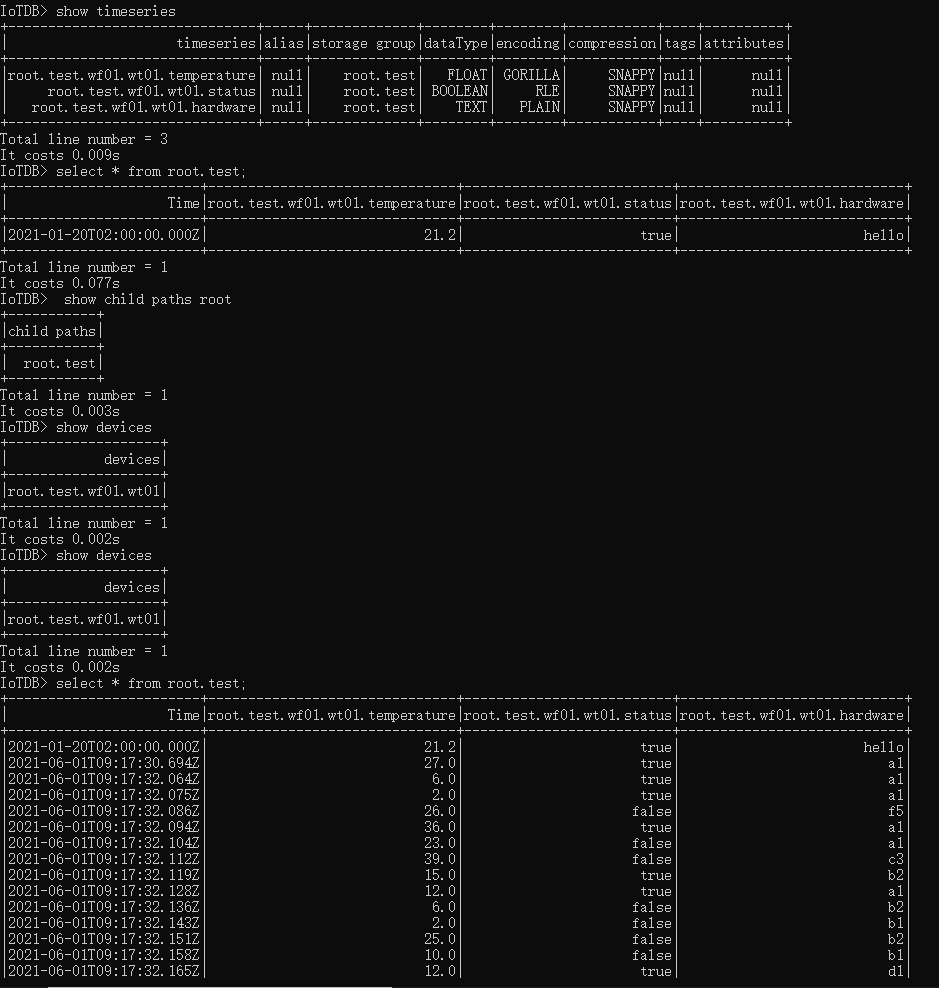首先,先允许我,祝各位读者小可爱们,节日快乐。
在这个系列之前的文章里,我们介绍了Iotdb的LSM,以及Iot中的最佳实践,这次我们看看如何将mqtt和Iotdb整合起来。下面我们开始:
iotdb in docker
首先,做一个测试环境,我现在越发喜欢docker 和 WSL 了,除了吃点硬盘,内存和CPU资源以外,没有什么缺点了......
run in docker
直接把该开的端口都打开,只是测试环境,我就没再挂目录。
docker run -d -p 6667:6667 -p 31999:31999 -p 8181:8181 -p 5555:5555 -p 1883:1883 apache/iotdb
等待一会,执行 docker ps 查看是否成功了
- ➜ ~ docker ps
- CONTAINER ID IMAGE COMMAND CREATED STATUS PORTS NAMES
- ad9b18f8bff3 apache/iotdb "/iotdb/sbin/start-s…" 2 hours ago Up 2 hours 0.0.0.0:1883->1883/tcp, :::1883->1883/tcp, 0.0.0.0:5555->5555/tcp, :::5555->5555/tcp, 0.0.0.0:6667->6667/tcp, :::6667->6667/tcp, 0.0.0.0:8181->8181/tcp, :::
初步的iotdb in docker 环境,我们就搞好了。接下来,开启mqtt服务。
开启 Mqtt 服务
进入iotdb的docker docker exec -it ad9b18f8bff3 /bin/bash
编辑配置文件vi iotdb/conf/iotdb-engine.properties
开启服务,根据自己的需要,配置ip和端口等。
- ####################
- ### MQTT Broker Configuration
- ####################
- # whether to enable the mqtt service.
- enable_mqtt_service=false # 修改成 true , 代表开启 mqtt服务
- # the mqtt service binding host.
- mqtt_host=0.0.0.0 # ip
- # the mqtt service binding port.
- mqtt_port=1883 # 端口
- # the handler pool size for handing the mqtt messages.
- mqtt_handler_pool_size=1
- # the mqtt message payload formatter.
- mqtt_payload_formatter=json # 数据格式
- # max length of mqtt message in byte
- mqtt_max_message_size=1048576
重启服务,如果不会,就重启docker镜像。
iotdb 基础操作
- 启动服务: sbin/start-client.sh
- root@ad9b18f8bff3:/iotdb/sbin# ./start-cli.sh
- ---------------------
- Starting IoTDB Cli
- ---------------------
- _____ _________ ______ ______
- |_ _| | _ _ ||_ _ `.|_ _ \
- | | .--.|_/ | | \_| | | `. \ | |_) |
- | | / .'`\ \ | | | | | | | __'.
- _| |_| \__. | _| |_ _| |_.' /_| |__) |
- |_____|'.__.' |_____| |______.'|_______/ version 0.11.1
- IoTDB> login successfully
- 退出CLI: quit 或 exit
- 停止服务:$sbin/stop-server.sh
- 设置一个存储组到IOTDB,名为root : IoTDB> SET STORAGE GROUP TO root
- 查看当前IOTDB的存储组 : IoTDB> SHOW STORAGE GROUP
- IoTDB> SHOW STORAGE GROUP
- +-------------+
- |storage group|
- +-------------+
- | root.test|
- +-------------+
- Total line number = 1
- It costs 0.127s
- 查看系统中存在的所有时间序列 :IoTDB> SHOW TIMESERIES
- IoTDB> show timeseries
- +-------------------------------+-----+-------------+--------+--------+-----------+----+----------+
- | timeseries|alias|storage group|dataType|encoding|compression|tags|attributes|
- +-------------------------------+-----+-------------+--------+--------+-----------+----+----------+
- |root.test.wf01.wt01.temperature| null| root.test| FLOAT| GORILLA| SNAPPY|null| null|
- | root.test.wf01.wt01.status| null| root.test| BOOLEAN| RLE| SNAPPY|null| null|
- | root.test.wf01.wt01.hardware| null| root.test| TEXT| PLAIN| SNAPPY|null| null|
- +-------------------------------+-----+-------------+--------+--------+-----------+----+----------+
- Total line number = 3
- It costs 0.009s
- 查看系统中存在的特定时间序列: SHOW TIMESERIES root.test.wf01.wt01.status
- IoTDB> SHOW TIMESERIES root.test.wf01.wt01.status
- +--------------------------+-----+-------------+--------+--------+-----------+----+----------+
- | timeseries|alias|storage group|dataType|encoding|compression|tags|attributes|
- +--------------------------+-----+-------------+--------+--------+-----------+----+----------+
- |root.test.wf01.wt01.status| null| root.test| BOOLEAN| RLE| SNAPPY|null| null|
- +--------------------------+-----+-------------+--------+--------+-----------+----+----------+
- Total line number = 1
- It costs 0.003s
- 插入数据 INSERT INTO root.test.wf01.wt01(timestamp,status,temperature) values(200,false,20.71)
- IoTDB> INSERT INTO root.test.wf01.wt01(timestamp,status,temperature) values(200,false,20.71)
- Msg: The statement is executed successfully.
- 查看数据: select * from root.test;
- IoTDB> select * from root.test;
- +------------------------+-------------------------------+--------------------------+----------------------------+
- | Time|root.test.wf01.wt01.temperature|root.test.wf01.wt01.status|root.test.wf01.wt01.hardware|
- +------------------------+-------------------------------+--------------------------+----------------------------+
- |2021-01-20T02:00:00.000Z| 21.2| true| hello|
- +------------------------+-------------------------------+--------------------------+----------------------------+
- Total line number = 1
- It costs 0.077s
- 查看设备:show devices
- IoTDB> show devices
- +-------------------+
- | devices|
- +-------------------+
- |root.test.wf01.wt01|
- +-------------------+
- Total line number = 1
- It costs 0.002s
mqtt to iotdb
代码
构建一个实体对象,用于存储
- package wang.datahub.iotdb;
- import com.google.gson.Gson;
- import java.util.List;
- public class IotdbVO {
- private String device;
- private long timestamp = System.currentTimeMillis();
- private List<String> measurements;
- private List<Object> values;
- public String getDevice() {
- return device;
- }
- public void setDevice(String device) {
- this.device = device;
- }
- public long getTimestamp() {
- return timestamp;
- }
- public void setTimestamp(long timestamp) {
- this.timestamp = timestamp;
- }
- public List<String> getMeasurements() {
- return measurements;
- }
- public void setMeasurements(List<String> measurements) {
- this.measurements = measurements;
- }
- public List<Object> getValues() {
- return values;
- }
- public void setValues(List<Object> values) {
- this.values = values;
- }
- public String toJson(){
- Gson g = new Gson();
- String jsonData = g.toJson(this);
- return jsonData;
- }
- @Override
- public String toString() {
- return "IotdbVO{" +
- "device='" + device + '\'' +
- ", timestamp=" + timestamp +
- ", measurements=" + measurements +
- ", values=" + values +
- '}';
- }
- }
使用祖传的代码来模拟数据发射到iotdb,这里直接将mqtt的主机和端口,配置到前文所修改的iotdb的mqtt服务上,就大功告成了。
- package wang.datahub.iotdb;
- import org.fusesource.mqtt.client.BlockingConnection;
- import org.fusesource.mqtt.client.MQTT;
- import org.fusesource.mqtt.client.QoS;
- import java.util.ArrayList;
- import java.util.List;
- import java.util.Random;
- public class EmmitToIotdb {
- public static void main(String[] args) {
- String[] hardwares = new String[]{
- "a1",
- "b1",
- "b2",
- "c3",
- "d1",
- "f5"
- };
- int count = 1000;
- for(int i = 0; i < count ;i++){
- IotdbVO iotdbVO = new IotdbVO();
- iotdbVO.setDevice("root.test.wf01.wt01");
- List<String> measurements = new ArrayList<>();
- List<Object> values = new ArrayList<>();
- measurements.add("temperature");
- measurements.add("status");
- measurements.add("hardware");
- Random r = new Random();
- values.add(r.nextInt(40));
- values.add(r.nextBoolean());
- values.add(hardwares[r.nextInt(hardwares.length)]);
- iotdbVO.setMeasurements(measurements);
- iotdbVO.setValues(values);
- emmitToIotdb(iotdbVO);
- }
- }
- public static void emmitToIotdb(IotdbVO content){
- try {
- MQTT mqtt = new MQTT();
- mqtt.setHost("127.0.0.1", 1883);
- mqtt.setUserName("root");
- mqtt.setPassword("root");
- BlockingConnection connection = mqtt.blockingConnection();
- connection.connect();
- String payload = content.toJson();
- connection.publish(content.getDevice(),payload.getBytes(), QoS.AT_LEAST_ONCE,false);
- connection.disconnect();
- } catch (Exception e){
- e.printStackTrace();
- }
- }
- }
执行结果
iotdb,功能还是相当强大的,也非常有意思,希望本篇文章对你有所帮助,也非常欢迎您来与我交流。
本文转载自微信公众号「麒思妙想」,可以通过以下二维码关注。转载本文请联系麒思妙想公众号。



































